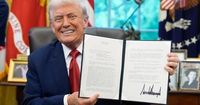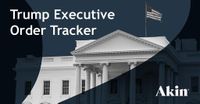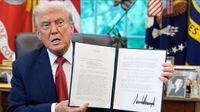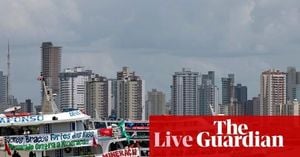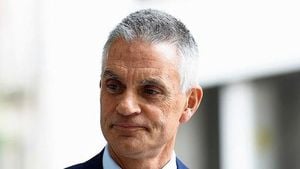On September 25, 2025, President Donald Trump signed a sweeping executive order and accompanying memorandum that marked a dramatic escalation in his administration’s campaign against what he and his officials have labeled "left-wing terrorism." The move, announced from the Oval Office, directs a whole-of-government effort to identify, investigate, and disrupt financial networks and organizations suspected of supporting domestic terrorism and political violence. The orders place the FBI’s Joint Terrorism Taskforce at the helm, with the Treasury Department, Department of Justice (DOJ), Internal Revenue Service (IRS), and other federal agencies coordinating in what Deputy Chief of Staff Stephen Miller described as “the first time in American history that there is an all-of-government effort to dismantle left-wing terrorism,” according to reporting from multiple outlets including the Associated Press and Truthout.
The executive order, titled “Countering Domestic Terrorism and Organized Political Violence,” specifically instructs federal law enforcement and financial regulators to prioritize the identification, disruption, and prosecution of those involved in funding and organizing acts of political violence. This includes not only individuals and groups, but also tax-exempt entities and foreign-linked actors. The Attorney General is now authorized to recommend the formal designation of domestic terrorism organizations—a power that, legal experts note, is not explicitly granted by existing U.S. law for domestic groups.
In his remarks, President Trump left little doubt about whom he believes are the culprits behind recent violence. He named two top Democratic donors—billionaires George Soros and Reid Hoffman—as potential funders of violent protests, though he offered no evidence to support the claim. “If they are funding these things, they're going to have some problems,” Trump said. He further alleged that “professional agitators and anarchists…get hired by wealthy people, some of whom I know,” echoing a narrative that has circulated widely in conservative media circles but has not been substantiated by law enforcement investigations to date.
The timing of the order follows two high-profile incidents: the assassination of conservative activist Charlie Kirk earlier in September and a shooting outside an Immigration and Customs Enforcement (ICE) building in Dallas that killed one detainee and wounded two others. Authorities have identified the suspected gunmen in both cases, but no evidence has been made public suggesting either was part of a larger network. In the ICE shooting, a note found at the gunman’s home read, “Yes, it was just me.” Nevertheless, Trump’s order cites these events—and other attacks on conservatives—as justification for the crackdown, even as critics point out that recent years have also seen deadly violence targeting Democrats and progressive figures, which the order does not mention.
According to Truthout, the memorandum goes further by defining “antifa” and related left-leaning groups in broad and ambiguous terms. It describes “antifa” beliefs as “anti-American,” “anti-capitalist,” and “anti-Christian,” and states that people who are hostile “towards those who hold traditional American views on family, religion, and morality” may be considered part of antifa. However, it does not clarify whether the government will target groups based on actual violent acts or simply for holding certain ideological positions. The memo, notably, fails to mention right-wing political violence, despite data showing that the majority of such incidents in the U.S. are perpetrated by right-leaning actors.
The executive order and memorandum direct the IRS to withdraw tax-exempt status from any organization identified as funding political violence, and to refer such organizations and their officers to the DOJ for investigation and potential prosecution. This echoes a previous Trump directive to investigate ActBlue, the Democratic Party’s main fundraising platform, while allowing its conservative counterpart to avoid similar scrutiny.
Legal observers have raised significant concerns about the scope and constitutionality of the new measures. “You can’t, by executive order, create new crimes,” Daniel Richman, a professor at Columbia Law School and former federal prosecutor, told The Guardian. “This does not create new crimes. This says you will use the Terrorism Task Force to go after things they would usually go after. The concern is that this administration has made clear it is only interested in pursuing politically oriented terrorism that disagrees with its political agenda.”
Chris Geidner, founder of the legal news site Law Dork, warned that the provisions could “potentially branch outward to anyone associated with people who later commit political violence or even actions that the Trump administration decides constitute ‘intimidation designed to suppress lawful political activity or obstruct the rule of law.’ That, on its face, is alarming.”
Civil liberties groups have responded swiftly and critically. The Open Society Foundation, funded by George Soros, issued a statement before Trump’s announcement, asserting, “These accusations are politically motivated attacks on civil society, meant to silence speech the administration disagrees with and undermine the First Amendment right to free speech.” Hina Shamsi, director of the American Civil Liberties Union’s (ACLU) National Security Project, described the move as “a shameful and dangerous move,” adding that Trump “cannot rewrite the Constitution by memo.” The ACLU and other advocacy groups have vowed to challenge the memorandum in court if the administration attempts to enforce it against activists or nonprofits.
Activists and journalists have also sounded the alarm about the chilling effect the new policies could have on free speech and political dissent. Jason Charter, an activist previously charged during Trump’s first term, said, “I fear how far they are going to take this. It’s trying to slap terrorism charges on people doing protected activities under the Bill of Rights.” Meanwhile, Truthout’s Editor-in-Chief Negin Owliaei and former Editor-in-Chief Maya Schenwar wrote that the administration “is indeed preparing to identify how to take out the entire progressive civil society ecosystem,” but argued that pushback from civil society and the media could help stem what they describe as a “fascistic tide.”
For supporters of the administration, the crackdown is seen as a necessary step to restore order and protect the public from what they view as organized, ideologically motivated violence. Vice President JD Vance and other top officials have echoed Trump’s rhetoric, although none have provided concrete evidence of a coordinated network funding left-wing violence. Stephen Miller, Trump’s deputy chief of staff, went as far as to label the Democratic Party a “domestic extremist organization” in a recent television appearance.
Yet, the move has deepened concerns across the political spectrum about the use of federal power to target political opponents and the potential erosion of First Amendment protections. As the administration presses forward, the coming weeks are likely to see a flurry of legal challenges, congressional scrutiny, and continued debate over the proper balance between security and civil liberties in a polarized America.
With the ink barely dry on the executive order, the battle lines are drawn—not just over the future of protest and political organizing in the United States, but over the very definition of domestic terrorism itself.
